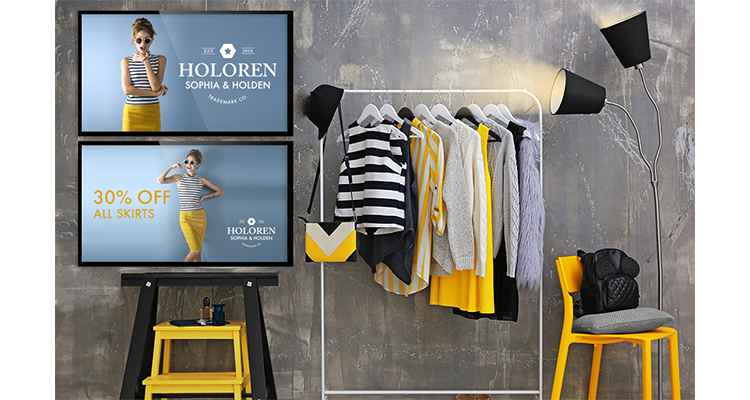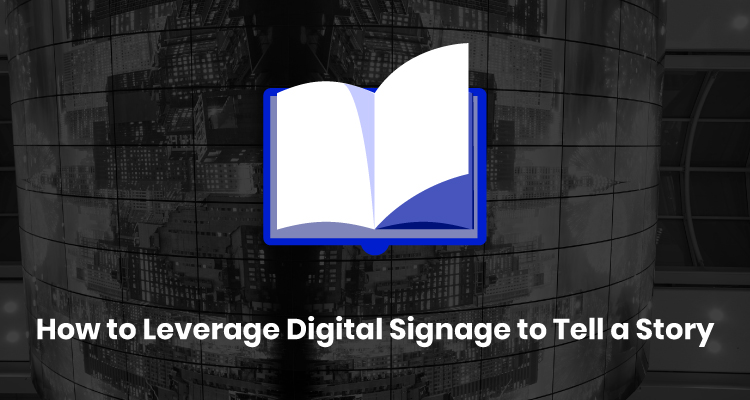Shopper Conversion Through Retail Shelf Media
The answer to confusion is always “no.” As product selection at the retail shelf is, by definition, a source of confusion for consumers, brands have a significant opportunity for point-of-purchase conversion through shelf level or service counter promotion.
When connecting the dots that represent the information and touch points on the ever-changing path to purchase, they ultimately converge at the shelf level. Even online ordering, the ever-increasing torture of physical space retailing with its “show-rooming”, is supported by shelf level media. The culture of shopping is moving forward as consumers seek information, inspiration, ever-changing stories that put the product in the context of their needs, wants, life and events.
In a session titled “The Future of Engagement” at the recent symposium hosted by the Digital Screenmedia Association, Jim Crawford, CEO of Chute Gerdeman and Ethan Whitehill, CEO of TwoWest provided insights about the retail experience. “Every store has a story,” Whitehill said. “How do you tell that story with technology? How do we enhance that story for the shopper?”
“Retail is mostly through brick-and-mortar stores, in large part because the in-store experience still provides utility, a sense of community and meaning” the panelists agreed. “Shopping happens because of the task, and the treat,” Whitehill said. “Brick and mortar delivers that better than any other experience.”
The two paramount marketing media questions that serve as the basis for action by the brand are a) Will consumers see the promotional message? And b) Will the message activate their action?
A resounding “yes” is the response to shelf level digital media. Dynamic media at the retail shelf reduces the “friction” at this most important of all points on the sometimes eclectic, always evolving path to purchase. Messaging that amplifies the brand identity and its promise at the point where the consumers hand moves products from a shelf to their cart, or places an order at a service counter deliver the prize that brands seek, including selection for trial or next use.
Many marketers, and consumers, believe that the consumer is at the center of the universe with buying power being a gravitational force that influences all brand and supply chain behavior. Emboldened by social media, consumers are happy to make brands feel the laurels or darts of their behavior.
Brand perception on the part of a consumer plays out at the store shelf. Appeal, disdain or indifference motivate product selection, as the marriage of convenience between brand and retailer works to device and execute sufficiently capable branding and promotional communications.
The arsenal of point-of-purchase instruments is fairly limited, typically including package design, shelf positioning, attractive pricing or some nearby static signs that aim to earn attention.
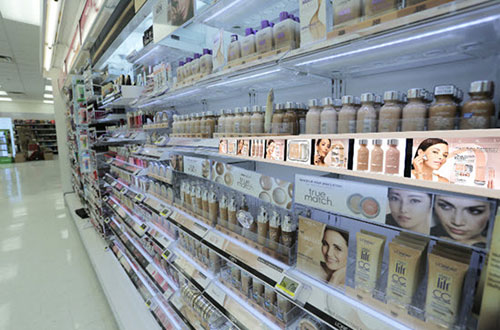
The retail shelf has been coined as the First Moment of Truth by Dina Howell, which proposed that all elements of marketing and promotion should be defined from shelf level interaction and then including merchandising, promotion, advertising and branding campaigns.
In a September 21, 2005 article on page 1 of the Wall Street Journal titled, “In a Shift, Marketers Beef Up Spending Inside Stores”, Procter and Gamble Co. reflected its belief that “shoppers make up their mind about a product selection in about the time it takes to read this [sentence].” Dina Howell, as director, First Moment of Truth (FMOT, pronounced EFF-mot), at Procter & Gamble, said “P&G wants to connect with consumers when and where they are most receptive to information about P&G Brands. We want to delight the consumer as well as simplify the shopping experience.” She said, “Working with retailers is pivotal to P&G success”, Ms. Howell added, “The store must be an extension of the brand and we must work in collaboration with retailers at that critical first moment of truth when a consumer makes the purchase decision”.
FMOT defines the point of product selection as the starting point for consumer goods marketing. In short, by appealing to consumer’s senses, values and emotions at the specific point of purchase, marketers can convert browsers to buyers and give their product the best chance of selection.
This “first moment of truth” as coined by P&G Acknowledges the decline in effectiveness of broadcast ad spending, the growing importance of retail media in the marketing mix, improved measurement capability and most importantly, the effectiveness of point-of-purchase and out-of-home ad display.
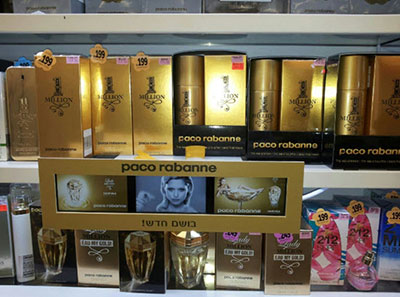
By inverting this marketing communications funnel, P&G has turned the questions to focus on achieving highest Return on Objectives. They ask, “In starting at the point of selection, how should we invest to achieve planned sales volumes and margins?” The basis of the planning and decision framework shifts to the achievement of effectiveness of “customer engagement” and relationship.
Retail marketing in this century harkens the important shift in 1694, when Galileo very successfully, and against established powers, that the sun was the center with planets and moons revolving around it, rather than the Earth being at the center.
In marketing, the brand has been central, but successful marketers accept that it is the consumer that is at the center, with brand options and the communications of each revolving around that buying power.
“The importance to growth of any brand is driven primarily by in-store visibility, consumer shop-ability and information that drives purchase decision,” says Jean-Pierre Lacroix, president, Shikatani Lacroix.
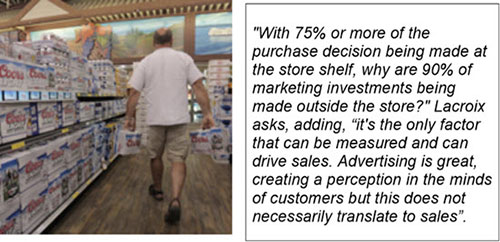
Russell Young, SVP, Interactive and Mobile Experiences at retail and dynamic media provider Stratacache says “Whether you call it the Point of Influence, or the Final Moment of Truth, there is no denying the importance of creating inspiration at the retail shelf level. Savvy brands and retailers realize this important point in the customer journey and continue to seek out innovative methods for driving conversion during these precious few seconds. The key to success in optimizing this shelf level engagement is to convey value in a subtle manner that feels natural in that specific environment.”
“Creating digital at-purchase moments is one of the most effective ways to influence purchase decision in-store,” notes Marcos Terenzio, director of digital experience, Shikatani Lacroix.
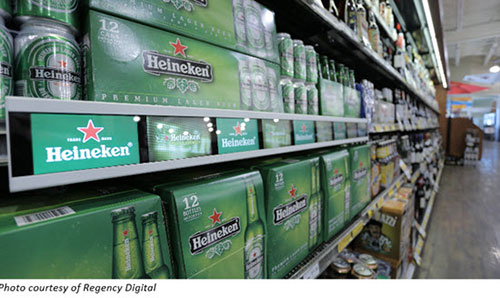
The value of shelf-level dynamic signage, says Laura Davis-Taylor SVP, director of Omnichannel Experience of The Integer Group, a member of the Publicis Omnicom Group of agencies, is “in being able to capture, connect and close in one fell swoop. The uniqueness of it can effectively capture attention unlike no other POP. It’s truly can’t miss. The attraction and content and call to action (CTA) can close them by answering their questions and lighting up their impulse propensity — sometimes in mere seconds.”
She adds, “It has worked well when ensuring that the way that the shopper encounters it is contextual to what they are trying to solve at the moment — in that particular store, in that category with that specific product”. By enabling consumer browsing, comparison, researching and selecting items in retail, it fits between Pre-Tail when consumers research and choose a store or website, and Post-Tail® beyond the purchase moment and product use.”
Andy McRae, general manager of Dot2Dot Communications, Inc. that provides the popular Scala content management platform and its additional capacities for third party advertising management, is a strong proponent for digital at and near-shelf media.
McRae says, “We have long felt that shelf level media is possibly the most important step in the path to purchase. Being able to influence the purchase decision at the shelf allows retailers to maximize value. Using a combination of omnichannel capability, real time networked appliances and displays, and advanced analytics capable of changing content to fit the situation gives retailer ultimate control over the shopper’s experience”.
“Devices such as Electronic Shelf Labels (ESLs) provide retailers with an easy way to change messaging, including pricing, based on any number of data inputs. Understanding the influences on a purchase decision is only half the equation. Having a system that allows changes to be made based on those influences, especially if it is automatic, completes the process,” he notes.
“Dynamic pricing has long been the ultimate goal for most industries, but retail in particular,” said McRae. He adds, “The advent of inexpensive, low power Electronic Shelf Labels combined with the robust content management system, and advanced purchase analytics offered by Scala have finally brought this from a manual process based on guesses to a highly automated process guided by facts.”
Says McRae, “More and more often retailers are asking for intelligent data driven communications networks for their store environments. These systems must offer purchase analytics, real time content update capability, integration with point of sale systems, and comprehensive result measurement. The displays themselves now range from large spectacular outdoor and outside — store viewable video walls designed to attract people into the store, to the very small Electronic Shelf Label (ESL) aimed at influencing the actual purchase decision.” McRae speculates that, “it is estimated that in the next 5 years, as much as 50 percent of purchases will be made online, or through mobile and social commerce so it is critical that any shelf level media have a mobile tie-in as a way of extending the shopping experience across multiple channels.”
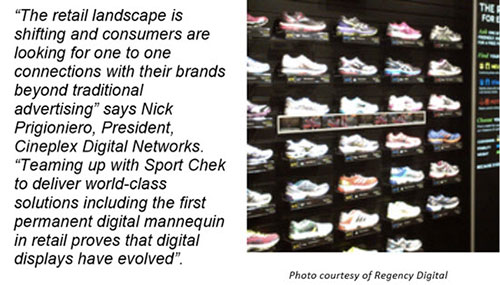
“Shoppers are looking for retailers to connect with them, make it easier to search, plan and purchase. We have been working with brands to capture data from on-shelf interactive displays, using it to measure business results and improve marketing strategies,” he said. “It’s all about strategy, scalability and relevancy. Our goal is always to make it easier for retailers to communicate and interact with today’s shoppers using the most advanced technology platforms.”
The Laurentien Bank has installed small screens horizontally under glass at the teller station. “This allows the client being served and signing paper such as deposits in front of the teller to see the digital screen messages with bank-related content, “ said Benoit Johnson, CEO of Montreal-based provider Viftele, which provides digital signage for the bank. “This screen allows the bank to have less small static signs at this specific space and the customers are presented with a hard to avoid message.”
“Empowering the consumer to have control and access to product information easily and conveniently is the key to their decision regarding what they buy. The value of shelf level digital media is that it is convenient and dynamic, and is a useful alternative to the mobile device though it can be used in conjunction with mobile to increase the brand reach,” says Suzana Spratley, CEO of the digital engagement agency TechTAP.
Spratley adds, “It is all about the connected consumer having control over their choices in an easy and convenient way. By placing the choice for the consumer in a digital medium at shelf height, the brand will offer more than one key decision point, for example, price as well as product features, benefits, ingredients, alternate uses, etc. Better choices bond consumers to brands and build advocates.” She emphasizes, “Brands must engage, inform and enhance the experience in a convenient and useful way.”
Displays are being used that maximize shelf space and do not displace any product frontage while being installed and operated.
A popular shelf dynamic display device is provided by Regency Digital. Vice president Abraham d’Ancona says, “The merchant is offered the opportunity to connect with the consumer. It reinforces the brand while maximizing shelf space and point-of-purchase consumer messaging that adds a sense of excitement, immediacy and urgency. In doing so,” adds d’Ancona, “It engages the patron to fulfill their needs and wants while also motivating product trial or an impulse buy. It is all about shopper conversion and product selection.”
The shelf video strip from Regency Digital includes multiple 2×4 inch video panels in a 1-inch deep housing that attaches easily to any retail shelf horizontally or vertically. Individual screens are able to play independently or in conjunction with each other and can be subdivided allowing for full color, high resolution video, animation, stills, QR codes or other engagement media. The device includes the display strip, a 2-inch cube media player that accommodates Wi-Fi or USB media loading, a mounting bracket and connection cables.
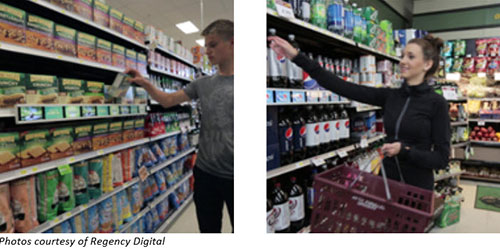
European retailers have already embraced shelf level dynamic media for more than two years, enabled by retail support agencies with retailer and brand relationships as well as experience with in-store merchandising /advertising or POP. “The most successful applications,” says d’Ancona, “have been where the shelf level video strip is the at-shelf element of a campaign that involved other promotion media. Products that have done especially well using shelf level video include new and aspirational products as well as market leading brands in consumables such as diapers, baby formula, chocolate, cosmetics, beverages, in particular when used in larger retail chains. Marketers who care about success in the retail store now have the tool that they need to generate more stock turns and gain market share over competitors at the retail shelf.”
“Getting the buyers attention has never been tougher, with so much messaging that it can just be noise to the buyer, that is why the video bar is so effective, it’s unique eye catching format at the point of decision engages the customer literally at his/her point of decision and delivers the motivation to buy,” notes Mike White, CEO of Multi-media Solutions, which has provided digital signage for award winning retail applications such as duty free shops at the Shoppes at Ocean Drive at Miami International Airport.
D’Ancona notes that the Regency Digital video strip is being used on a constant basis in two of the leading retailer supermarkets and drug stores, and that brands tend to use the shelf level video strip on an ongoing basis after an initial trial.
Jose Avalos, Director, Visual Retail, Retail Solutions Division for Intel Corporation in the Embedded & Communications Group concludes “Digital Signage as an ingredient can be transformational to numerous product categories like Interactive Whiteboards for education, Digital jukeboxes for hospitality and transparent displays for supermarkets, among others. In the retail sector it is understood that 68 percent of all purchases are unplanned and 70 percent of brand choices are made at the shelf. The advent of Intelligent Shelving with integrated advertising and information content can fulfill a much more active role where it understands shopper needs, understands the product or products it is showcasing, and uses enhanced capabilities to participate more fully in the selling process. And it can do this in a way that is highly personalized, including the use of personalized pricing and promotions.” He adds “For manufacturers, an intelligent shelf can create data-led sales and marketing opportunities and help them better understand who is buying their products, and who is not. It can also maximize profit for the retailer by optimizing pricing dynamically, and enable manufacturers and retailers to reward shopper loyalty, all at the shelf edge.”
The consumer is at the center of the universe and that most essential of marketing success points, the moment of truth, is the retail shelf. Brand campaigns, retailer policy and the supply of shelf level display must align. As they do, the shopper will deliver benefits to all.
Lyle Bunn (Ph.D. Hon) is an analyst, adviser and educator in North America’s digital out-of-home industry. He has been recognized with six industry awards, helped hundreds of organizations to take advantage of dynamic signage, has published almost 300 articles, whitepapers and guidebooks, and has helped to train more than 10,000 media and supply professionals.
This column was reprinted with permission from the Digital Screenmedia Association and originally appeared here.



